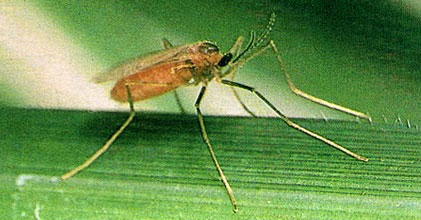Rice gall midge
Orseolia oryzae (Wood-Mason)
What it does
 Rice gall midge forms a tubular gall at the base of tillers, causing elongation of leaf sheaths called onion leaf or silver shoot.
Rice gall midge forms a tubular gall at the base of tillers, causing elongation of leaf sheaths called onion leaf or silver shoot.
Why and where it occurs
The Asian rice gall midge is found in irrigated or rainfed wetland environments during the tillering stage of the rice crop. It is also common in upland and deepwater rice. The adults are nocturnal and can easily be collected using light traps.
During the dry season, the insect remains dormant in the pupal stage. They become active again when the buds start growing after the rains.
The population density of the Asian rice gall midge is favored mainly by cloudy or rainy weather, cultivation of high-tillering varieties, intensive management practices, and low parasitization.
How to identify
Symptoms of rice gall midge damage include:
- formation of a hollow cavity or tubular gall at the base of the infested tiller. The gall formed is a silvery white hollow tube, 1 cm wide and 10−30 cm long
- affected tiller inhibits growth of leaves and fails to produce panicles
- deformed, wilted, and rolled leaf
- elongation of leaf sheaths, also called onion leaf or silvershoot
- plant stunting
The plant stunting and leaf deformity, wilting and rolling are also symptoms observed on plants caused by drought, potassium deficiency, salinity, and ragged stunt virus, orange leaf virus and tungro virus diseases.
The rolled leaves can also be associated with the symptom caused by rice thrips. To confirm cause of problem, check for presence of insect. Particularly, elongate-tubular eggs and maggot-like larva feeding inside developing buds.
Why is it important
The Asian gall midge can cause significant yield losses of 30−40% in some areas like Sri Lanka and parts of India.
How to manage
- Use resistant varieties. Contact your local agriculture office for up-to-date lists of varieties available.
- Plow ratoon of the previous crop and remove all off-season plant hosts.
- Encourage biological control agents: platygasterid, eupelmid, and pteromalid wasps (parasitize the larvae), phytoseiid mites (feed on eggs), spiders (feed on adults).







